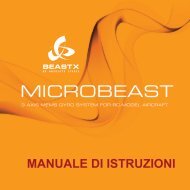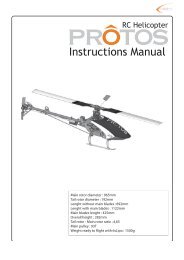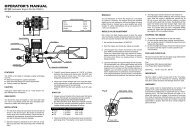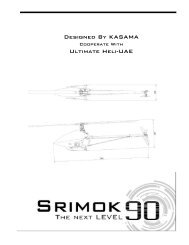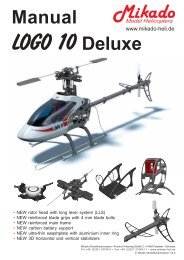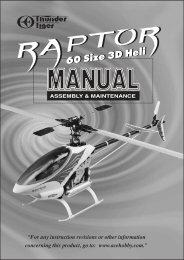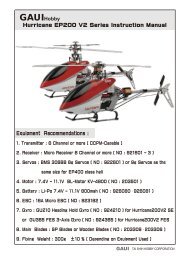Spartan Quark Gyro Installation Guide [Doc. v1.0] - Spartan RC
Spartan Quark Gyro Installation Guide [Doc. v1.0] - Spartan RC
Spartan Quark Gyro Installation Guide [Doc. v1.0] - Spartan RC
- No tags were found...
Create successful ePaper yourself
Turn your PDF publications into a flip-book with our unique Google optimized e-Paper software.
<strong>Gyro</strong> Operating Gain > 100%<br />
Rate<br />
80% 0% 77% 100%<br />
AVCS<br />
Gain Pulse Width 1020uS 1520uS 2020uS<br />
Futaba <strong>Gyro</strong> Menu 100% 0% 100%<br />
Futaba Endpoints 90% 0% 90%<br />
JR/Spektrum <strong>Gyro</strong> Menu - 0% 51% 100% -<br />
JR/Spektrum Endpoints 126% 1% 129%<br />
Important:<br />
• The optimal gain value is the highest value you can reach<br />
that does not cause tail wag at any time during flight.<br />
• Do not use any type of stick priority mixing or other gain<br />
reduction mixing.<br />
The optimal gain value is a function of several parameters<br />
including rotor speed, tail rotor diameter, tail blade efficiency,<br />
servo arm length, servo make/model and mechanical design<br />
of the aircraft. As such, it is not possible to make a general<br />
recommendation and therefore the gain will need to be<br />
adjusted experimentally. Start with a gain of 30%, this should<br />
provide enough stability to at least hover; however you<br />
should always proceed with care. If insufficient stabilisation or<br />
tail wag is seen the gain should be raised or lowered<br />
respectively. It is not uncommon to find that the optimal gain<br />
value for a helicopter could be as small as 35-45%. A small<br />
15


![Spartan Quark Gyro Installation Guide [Doc. v1.0] - Spartan RC](https://img.yumpu.com/53147979/17/500x640/spartan-quark-gyro-installation-guide-doc-v10-spartan-rc.jpg)
